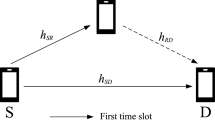Abstract
When the sizes of terminals are limited, cooperative relay networks are recommended as promising virtual MIMO systems to improve the performances of wireless communication systems in literature. Accordingly, some comparisons on the performances of different systems are useful to guide the selection and deployment of cooperative relay systems in field applications. In this paper, we compare the outage probabilities of cooperative relay networks of different topologies (different numbers of antennas used at a transmitter and relays used in a system), as well as the outage probabilities of the MISO systems. We propose an aggregated channel mode, which combines the power gain obtained from the reduction of path loss through the deployment of relays, and the flat fading caused by multi-path propagation. During the evaluation of the performances of different systems, we apply information theory in the calculation of ergodic capacities and consider the requirement on wireless resources in the estimation of outage probabilities. Numerical simulation shows that (1) cooperative networks with multiple relays outperform those with multiple antennas; (2) only when the power gain is included, the performances of cooperative relay networks are comparable with their counterparts in direct transmission; (3) the performances are significantly affected by the locations of relays.
Similar content being viewed by others
References
Sendonaris A., Erkip E., Aazhang B. (2003) User cooperation diversity. Part I. System description. IEEE Transactions on Communications 51(11): 1927–1938
Sendonaris A., Erkip E., Aazhang B. (2003) User cooperation diversity. Part II. Implementation aspects and performance analysis. IEEE Transactions on Communications 51(11): 1939–1948
Hasna M., Alouini M. (2003) End-to-end performance of transmission systems with relays over Rayleigh-fading channels. IEEE Transactions on Wireless Communications 2: 1126–1131
Hasna M., Alouini M. (2004) Harmonic mean and end-to-end performance of transmission systems with relays. IEEE Transactions on Communications 52: 130–135
Anghel P. A., Kaveh M. (2004) Exact symbol error probability of a cooperative network in a Rayleigh-fading environment. IEEE Transactions on Wireless Communications 3: 1416–1421
Boyer, J., Falconer, D. D., & Yanikomeroglu, H. (2004). Multihop diversity in wireless relaying channels. IEEE Transactions on Communications, 52 (10).
Laneman J. N., Tse D. N. C., Wornell G. W. (2004) Cooperative diversity in wireless networks: Efficient protocols and outage behavior. IEEE Transactions on Information Theory 49: 3062–3080
Ribeiro A., Cai X., Giannikis G. B. (2005) Symbol error probabilities for general cooperative links. IEEE Transactions on Wireless Communications 4: 1264–1273
Nahas M., Saadani A., Hachem W. (2010) Performance of asynchronous two-relay two-hop wireless cooperative networks. IEEE Transactions on Wireless Communications 9(3): 1086–1096
Conne C., Kim I. (2010) Outage probability of multi-hop amplify-and-forward relay systems. IEEE Transactions on Wireless Communications 9(3): 1139–1149
Sadek A. K., Zhu H., Liu K. J. R. (2010) Relay-assignment protocols for coverage expansion in cooperative wireless networks. IEEE Transactions on Mobile Computing 9(4): 505–515
Conne C., Ju M., Yi Z., Song H., Kim I. (2010) SER analysis and PDF derivation for multi-hop amplify-and-forward relay systems. IEEE Transactions on Communications 58(8): 2413–2424
Safari M., Uysal M. (2008) Cooperative diversity over log-normal fading channels: Performance analysis and optimization. IEEE Transactions on Wireless Communications 7(5): 1963–1972
Wu L., Niu K., He Z., Xu W., Lin J. (2009) Ergodic capacity of dual-hop transmissions over composite multipath/shadowing channels. Electronic Letters 45(19): 975–976
Cover T. M., Thomas J. A. (2006) Elements of information theory (2nd ed.). New York; Wiley.
Alamouti S. M. (1998) A simple transmit diversity technique for wireless communications. IEEE Journal of Selected Areas in Communications 16(8): 1451–1458
Author information
Authors and Affiliations
Corresponding author
Rights and permissions
About this article
Cite this article
Huang, C., Zhang, XP. Performances of Amplify-and-Forward Cooperative Relay Networks with Different Topologies. Wireless Pers Commun 69, 561–577 (2013). https://doi.org/10.1007/s11277-012-0590-x
Published:
Issue Date:
DOI: https://doi.org/10.1007/s11277-012-0590-x




